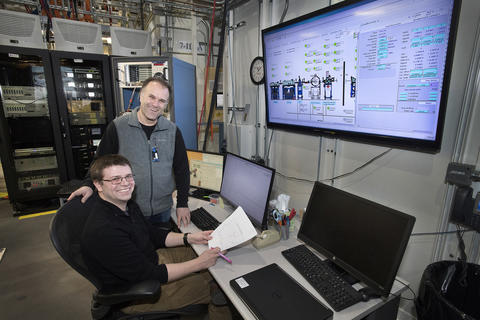Industry a key component of newly commissioned NIST beamline at Brookhaven National Laboratory
Beamline for Material Measurement launches operations

Pratt & Whitney Senior Engineer Chris Pellicone (left) with NIST's Bruce Ravel (right) at the Beamline for Material Measurement (BMM)
Building off of a nearly 40 year partnership with Brookhaven National Laboratory (BNL), NIST has recently completed and commissioned the Beamline for Material Measurement (BMM). This beamline features two experimental stations, for X-ray adsorption fine structure (XAFS) and X-ray diffraction (XRD). The beamline is the first of three to be commissioned by NIST at the new National Synchrotron Light Source II (NSLS-II), a world-class light source funded by the Department of Energy to enable the next generation of synchrotron X-ray capabilities. Stationed permanently at NSLS-II, the NIST Synchrotron Science Group continues a longstanding emphasis on industrial collaborations. In fact, the beamline itself is supported through a continuing partnership with IBM, who has designed, funded, and operates the XRD station in full collaboration with NIST.
Recently, the first experimental station (XAFS) completed commissioning and entered full operations. The first experiment featured a collaboration with researchers from jet engine manufacturer Pratt & Whitney. The team measured the absorption of X-rays by a ceramic coating used to control temperature in jet engines during flight. Due to the design of the instrument, the absorption can be monitored while tuning the X-ray energy. As the excitation energy of elements of interest are crossed, the resulting modulations in absorption reveal details of local atomic structure and chemistry, providing insight into the chemical origins of material performance. The high brilliance of the NSLS-II allows NIST scientists to tailor the instrumentation with small, focused beams and high flux to measure chemistry in a wide variety of materials, including crystals, liquid crystals, liquids, metals, and insulators. More information on these measurements can be found at a press release produced by Brookhaven National Laboratory.

